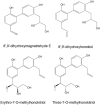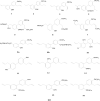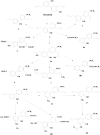Neuropharmacological potential of honokiol and its derivatives from Chinese herb Magnolia species: understandings from therapeutic viewpoint
- PMID: 38001538
- PMCID: PMC10668527
- DOI: 10.1186/s13020-023-00846-1
Neuropharmacological potential of honokiol and its derivatives from Chinese herb Magnolia species: understandings from therapeutic viewpoint
Abstract
Honokiol is a neolignan biphenol found in aerial parts of the Magnolia plant species. The Magnolia plant species traditionally belong to China and have been used for centuries to treat many pathological conditions. Honokiol mitigates the severity of several pathological conditions and has the potential to work as an anti-inflammatory, anti-angiogenic, anticancer, antioxidant, and neurotherapeutic agent. It has a long history of being employed in the healthcare practices of Southeast Asia, but in recent years, a greater scope of research has been conducted on it. Plenty of experimental evidence suggests it could be beneficial as a neuroprotective bioactive molecule. Honokiol has several pharmacological effects, leading to its exploration as a potential therapy for neurological diseases (NDs), including Alzheimer's disease (AD), Parkinson's disease (PD), cerebral ischemia, anxiety, depression, spinal cord injury, and so on. So, based on the previous experimentation reports, our goal is to discuss the neuroprotective properties of honokiol. Besides, honokiol derivatives have been highlighted recently as possible therapeutic options for NDs. So, this review focuses on honokiol's neurotherapeutic actions and toxicological profile to determine their safety and potential use in neurotherapeutics.
Keywords: Alzheimer’s disease; Anxiety; Chinese Herb; Depression; Honokiol; Ischemia; Magnolia species; Neurological diseases; Parkinson’s disease.
© 2023. The Author(s).
Conflict of interest statement
The authors declare that they have no competing interests.
Figures






Similar articles
-
The Neuropharmacological Effects of Magnolol and Honokiol: A Review of Signal Pathways and Molecular Mechanisms.Curr Mol Pharmacol. 2023;16(2):161-177. doi: 10.2174/1874467215666220223141101. Curr Mol Pharmacol. 2023. PMID: 35196977 Review.
-
Honokiol: A review of its pharmacological potential and therapeutic insights.Phytomedicine. 2021 Sep;90:153647. doi: 10.1016/j.phymed.2021.153647. Epub 2021 Jul 16. Phytomedicine. 2021. PMID: 34362632 Review.
-
Localization and Aggregation of Honokiol in the Lipid Membrane.Antioxidants (Basel). 2024 Aug 22;13(8):1025. doi: 10.3390/antiox13081025. Antioxidants (Basel). 2024. PMID: 39199269 Free PMC article.
-
Neuroprotective effects of honokiol: from chemistry to medicine.Biofactors. 2017 Nov;43(6):760-769. doi: 10.1002/biof.1385. Epub 2017 Aug 17. Biofactors. 2017. PMID: 28817221 Review.
-
Naringenin: A prospective therapeutic agent for Alzheimer's and Parkinson's disease.J Food Biochem. 2022 Dec;46(12):e14415. doi: 10.1111/jfbc.14415. Epub 2022 Sep 15. J Food Biochem. 2022. PMID: 36106706 Review.
Cited by
-
Honokiol ameliorates reserpine-induced fibromyalgia through antioxidant, anti-inflammatory, neurotrophic, and anti-apoptotic mechanisms.Sci Rep. 2025 Jul 17;15(1):25983. doi: 10.1038/s41598-025-07209-w. Sci Rep. 2025. PMID: 40676048 Free PMC article.
-
A fluorescent STING ligand sensor for high-throughput screening of compounds that can enhance tumor immunotherapy.Cell Rep Methods. 2025 Jul 21;5(7):101106. doi: 10.1016/j.crmeth.2025.101106. Epub 2025 Jul 15. Cell Rep Methods. 2025. PMID: 40669456 Free PMC article.
-
Role of Ciminalum-4-thiazolidinone Hybrids in Molecular NF-κB Dependent Pathways.Int J Mol Sci. 2024 Jul 3;25(13):7329. doi: 10.3390/ijms25137329. Int J Mol Sci. 2024. PMID: 39000436 Free PMC article.
-
Natural Compounds That Target Glioma Stem Cells.NeuroSci. 2025 Jun 5;6(2):52. doi: 10.3390/neurosci6020052. NeuroSci. 2025. PMID: 40559213 Free PMC article. Review.
-
Honokiol Is More Potent than Magnolol in Reducing Head and Neck Cancer Cell Growth.Curr Issues Mol Biol. 2024 Sep 25;46(10):10731-10744. doi: 10.3390/cimb46100637. Curr Issues Mol Biol. 2024. PMID: 39451517 Free PMC article.
References
Publication types
LinkOut - more resources
Full Text Sources

